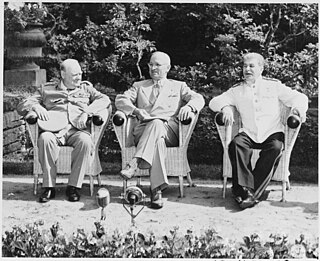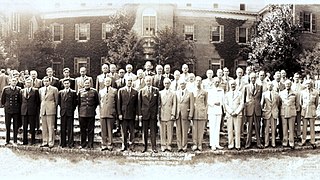Related Research Articles

The Potsdam Conference was held at Potsdam in the Soviet occupation zone from July 17 to August 2, 1945, to allow the three leading Allies to plan the postwar peace, while avoiding the mistakes of the Paris Peace Conference of 1919. The participants were the Soviet Union, the United Kingdom, and the United States. They were represented respectively by General Secretary Joseph Stalin, Prime Ministers Winston Churchill and Clement Attlee, and President Harry S. Truman. They gathered to decide how to administer Germany, which had agreed to an unconditional surrender nine weeks earlier. The goals of the conference also included establishing the postwar order, solving issues on the peace treaty, and countering the effects of the war.

The Tehran Conference was a strategy meeting of the Allies of World War II, held between Joseph Stalin, Franklin D. Roosevelt, and Winston Churchill from 28 November to 1 December 1943. It was the first of the Allied World War II conferences involving the "Big Three" and took place at the Soviet embassy in Tehran just over a year after the Anglo-Soviet invasion of Iran. The meeting occurred shortly after the Cairo Conference was held in Egypt for a discussion between the United States, the United Kingdom, and China from 22 to 26 November 1943. The Big Three would not meet again until 1945, when the Yalta Conference was held in Crimea from 4 to 11 February and the Potsdam Conference was held in Allied-occupied Germany from 17 July to August 2.

The Yalta Conference, held 4–11 February 1945, was the World War II meeting of the heads of government of the United States, the United Kingdom and the Soviet Union to discuss the postwar reorganization of Germany and Europe. The three states were represented by President Franklin D. Roosevelt, Prime Minister Winston Churchill, and General Secretary Joseph Stalin. The conference was held near Yalta in Crimea, Soviet Union, within the Livadia, Yusupov, and Vorontsov palaces.

The Dumbarton Oaks Conference, or, more formally, the Washington Conversations on International Peace and Security Organization, was an international conference at which proposals for the establishment of a "general international organization", which was to become the United Nations, were formulated and negotiated. The conference was led by the Four Policemen – the United States, the United Kingdom, the Soviet Union, and China. It was held at the Dumbarton Oaks estate in Washington, D.C., from August 21, 1944, to October 7, 1944.

The Cairo Conference, also known as the First Cairo Conference, was one of 14 summit meetings during World War II, which took place on November 22–26, 1943. The Conference was held at Cairo in Egypt between China, the United Kingdom and the United States. Attended by Chairman Chiang Kai-shek, British Prime Minister Winston Churchill and US President Franklin D. Roosevelt, it outlined the Allied position against the Empire of Japan during World War II and made decisions about post-war Asia.

The Cold War emerged from the breakdown of relations between two of the primary victors of World War II: the United States and Soviet Union, along with their respective allies in the Western Bloc and Eastern Bloc. This ideological and political rivalry, which solidified between 1945-49, would shape the global order for the next four decades.

The history of the United Nations has its origins in World War II beginning with the Declaration of St James's Palace. Taking up the Wilsonian mantle in 1944–1945, US President Franklin D. Roosevelt pushed as his highest postwar priority the establishment of the United Nations to replace the defunct League of Nations. Roosevelt planned that it would be controlled by the United States, Soviet Union, United Kingdom and China. He expected this Big Four would resolve all major world problems at the powerful Security Council. However the UN was largely paralyzed by the veto of the Soviet Union when dealing with Cold War issues from 1947 to 1989. Since then its aims and activities have expanded to make it the archetypal international body in the early 21st century.

The Declaration by United Nations was the main treaty that formalized the Allies of World War II and was signed by 47 national governments between 1942 and 1945. On 1 January 1942, during the Arcadia Conference in Washington D.C., the Allied "Big Four"—the United States, the United Kingdom, the Soviet Union, and China—signed a short document which later came to be known as the United Nations Declaration, and the next day the representatives of 22 other nations added their signatures.
The Moscow Declarations were four declarations signed during the Moscow Conference on October 30, 1943. The declarations are distinct from the communique that was issued following the Moscow Conference of 1945. They were signed by the foreign secretaries of the governments of the United States, the United Kingdom, the Soviet Union and the Republic of China. Four declarations were signed at the conference: The Declaration of the Four Nations on General Security, the Declaration on Italy, the Declaration on Austria, and the Declarations on Atrocities.

The Allies, formally referred to as the United Nations from 1942, were an international military coalition formed during World War II (1939–1945) to oppose the Axis powers. Its principal members by the end of 1941 were the "Big Four" – the United Kingdom, United States, Soviet Union, and China.

The Third Moscow Conference between the major Allies of World War II took place during October 18 to November 11, 1943, at the Moscow Kremlin and Spiridonovka Palace. It was composed of major diplomats, ministers and generals, who discussed cooperation in the war effort, and issued the Moscow Declaration.
The United Kingdom is a founding member of the United Nations and one of five permanent members of the UN Security Council.

The "Four Policemen" was a postwar council with the Big Four that US President Franklin Roosevelt proposed as a guarantor of world peace. Their members were called the Four Powers during World War II and were the four major Allies of World War II: the United Kingdom, the United States, the Soviet Union, and China. Roosevelt repeatedly used the term "Four Policemen" starting in 1942.
The Fourth Moscow Conference, also known as the Tolstoy Conference for its code name Tolstoy, was a meeting in Moscow between Winston Churchill and Joseph Stalin from 9 to 19 October 1944.
The diplomatic history of World War II includes the major foreign policies and interactions inside the opposing coalitions, the Allies of World War II and the Axis powers, between 1939 and 1945.

The term Big Four Conference may refer to one of several conferences between heads of state or foreign ministers of the victorious nations after World War I (1914–18) or during and after World War II (1939–45).

The UK-US relations in World War II comprised an extensive and highly complex relationship, in terms of diplomacy, military action, financing, and supplies. British Prime Minister Winston Churchill and American President Franklin D. Roosevelt formed close personal ties, that operated apart from their respective diplomatic and military organizations.

The third presidential term of Franklin D. Roosevelt began on January 20, 1941, when he was once again inaugurated as the 32nd president of the United States, and the fourth term of his presidency ended with his death on April 12, 1945. Roosevelt won a third term by defeating Republican nominee Wendell Willkie in the 1940 United States presidential election. He remains the only president to serve for more than two terms. Unlike his first two terms, Roosevelt's third and fourth terms were dominated by foreign policy concerns, as the United States became involved in World War II in December 1941.

The main issues of the United States foreign policy during the 1945–1953 presidency of Harry S. Truman include:
The foreign policy of the United States was controlled personally by Franklin D. Roosevelt during his first and second and third and fourth terms as the president of the United States from 1933 to 1945. He depended heavily on Henry Morgenthau Jr., Sumner Welles, and Harry Hopkins. Meanwhile, Secretary of State Cordell Hull handled routine matters. Roosevelt was an internationalist, while powerful members of Congress favored more isolationist solutions in order to keep the U.S. out of European wars. There was considerable tension before the Attack on Pearl Harbor in December 1941. The attack converted the isolationists or made them irrelevant. The US began aid to the Soviet Union after Germany invaded it in June 1941. After the US declared war in December 1941, key decisions were made at the highest level by Roosevelt, Britain's Winston Churchill and the Soviet Union's Joseph Stalin, along with their top aides. After 1938 Washington's policy was to help China in its war against Japan, including cutting off money and oil to Japan. While isolationism was powerful regarding Europe, American public and elite opinion strongly opposed Japan.
References
- ↑ Garver 1988, p. 194.
- ↑ United Nations Documents 1941–1945. Oxford University Press for the Royal Institute Of International Affairs. 1946.
- ↑ "Milestones in the History of U.S. Foreign Relations - Office of the Historian". history.state.gov. Retrieved 9 November 2024.
- 1 2 Dallek 1995, p. 420.
Sources
- Dallek, Robert (1995). Franklin D. Roosevelt and American Foreign Policy, 1932–1945: With a New Afterword. Oxford University Press. ISBN 978-0-19-982666-7.
- Garver, John W. (1988). Chinese-Soviet Relations, 1937–1945: The Diplomacy of Chinese Nationalism: The Diplomacy of Chinese Nationalism. Oxford University Press. ISBN 978-0-19-536374-6.